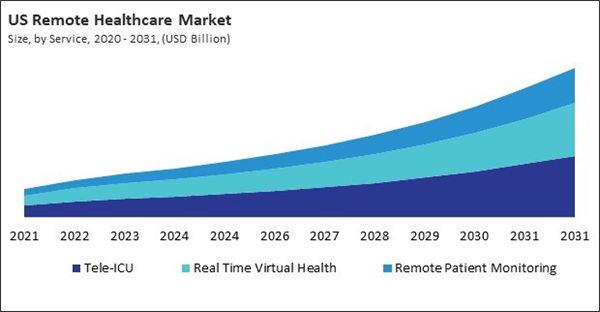The North America Remote Healthcare Market would witness market growth of 16.0% CAGR during the forecast period (2024-2031).
The US market dominated the North America Remote Healthcare Market by Country in 2023, and would continue to be a dominant market till 2031; thereby, achieving a market value of $8.06 billion by 2031. The Canada market is experiencing a CAGR of 18.4% during (2024 - 2031). Additionally, The Mexico market would exhibit a CAGR of 17.5% during (2024 - 2031).
Health coaching services are offered through remote platforms, providing personalized advice and support on lifestyle changes, fitness, and wellness. These coaches use video calls, messaging, and app-based tools to guide and motivate patients toward healthier behaviors.
Additionally, tracking sleep patterns and diagnosing sleep disorders, including sleep apnea, are capabilities of specialized remote sleep monitoring devices. Sleep specialists can analyze data collected from these devices to provide insights and recommendations for improving sleep health.
Canada’s aging population is experiencing a higher prevalence of chronic diseases like hypertension, diabetes, and arthritis. Remote healthcare solutions, including telehealth consultations and remote monitoring, are becoming essential for managing these conditions effectively, reducing the need for frequent in-person visits. As per Statistics Canada, in 2022, there were 7,330,605 people aged 65 and older in Canada. Moreover, over 861,000 people aged 85 and older were counted in the 2021 Census, more than twice the number observed in the 2001 Census. Many older Canadians live in rural or remote areas with limited healthcare services. Remote healthcare provides a vital link to medical professionals and specialist care for these individuals, bridging gaps in access and reducing travel burdens.
Based on Service, the market is segmented into Tele-ICU, Real Time Virtual Health (Video Communication, Audio Communication, and Email/Chat box), and Remote Patient Monitoring. Based on End Use, the market is segmented into Provider, Payer, Patient, and Employer Groups & Government Organizations. Based on countries, the market is segmented into U.S., Mexico, Canada, and Rest of North America.
The US market dominated the North America Remote Healthcare Market by Country in 2023, and would continue to be a dominant market till 2031; thereby, achieving a market value of $8.06 billion by 2031. The Canada market is experiencing a CAGR of 18.4% during (2024 - 2031). Additionally, The Mexico market would exhibit a CAGR of 17.5% during (2024 - 2031).
Health coaching services are offered through remote platforms, providing personalized advice and support on lifestyle changes, fitness, and wellness. These coaches use video calls, messaging, and app-based tools to guide and motivate patients toward healthier behaviors.
Additionally, tracking sleep patterns and diagnosing sleep disorders, including sleep apnea, are capabilities of specialized remote sleep monitoring devices. Sleep specialists can analyze data collected from these devices to provide insights and recommendations for improving sleep health.
Canada’s aging population is experiencing a higher prevalence of chronic diseases like hypertension, diabetes, and arthritis. Remote healthcare solutions, including telehealth consultations and remote monitoring, are becoming essential for managing these conditions effectively, reducing the need for frequent in-person visits. As per Statistics Canada, in 2022, there were 7,330,605 people aged 65 and older in Canada. Moreover, over 861,000 people aged 85 and older were counted in the 2021 Census, more than twice the number observed in the 2001 Census. Many older Canadians live in rural or remote areas with limited healthcare services. Remote healthcare provides a vital link to medical professionals and specialist care for these individuals, bridging gaps in access and reducing travel burdens.
Based on Service, the market is segmented into Tele-ICU, Real Time Virtual Health (Video Communication, Audio Communication, and Email/Chat box), and Remote Patient Monitoring. Based on End Use, the market is segmented into Provider, Payer, Patient, and Employer Groups & Government Organizations. Based on countries, the market is segmented into U.S., Mexico, Canada, and Rest of North America.
List of Key Companies Profiled
- Abbott Laboratories
- GE HealthCare Technologies, Inc.
- American Well Corporation (Amwell)
- Koninklijke Philips N.V.
- Medtronic PLC
- Teladoc Health, Inc.
- Honeywell International, Inc.
- Resideo Technologies, Inc.
- Siemens Healthineers AG (Siemens AG)
- Oracle Corporation
Market Report Segmentation
By
Service
- Tele-ICU
- Real Time Virtual Health
- Video Communication
- Audio Communication
- Email/Chat box
- Remote Patient Monitoring
By End Use
- Provider
- Payer
- Patient
- Employer Groups & Government Organizations
By Country
- US
- Canada
- Mexico
- Rest of North America
Table of Contents
Chapter 1. Market Scope & Methodology
Chapter 2. Market at a Glance
Chapter 3. Market Overview
Chapter 4. Competition Analysis - Global
Chapter 5. North America Remote Healthcare Market by Service
Chapter 6. North America Remote Healthcare Market by End Use
Chapter 7. North America Remote Healthcare Market by Country
Chapter 8. Company Profiles
Companies Mentioned
- Abbott Laboratories
- GE HealthCare Technologies, Inc.
- American Well Corporation (Amwell)
- Koninklijke Philips N.V.
- Medtronic PLC
- Teladoc Health, Inc.
- Honeywell International, Inc.
- Resideo Technologies, Inc.
- Siemens Healthineers AG (Siemens AG)
- Oracle Corporation
Methodology

LOADING...









